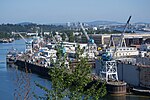Northwest Industrial, Portland, Oregon

Northwest Industrial Area is an almost entirely industrial neighborhood in the Northwest section of Portland. According to the Portland Bureau of Planning, it "is one of the few remaining large urban industrial districts in the United States" and "one of the premier heavy industrial districts in the Pacific Northwest". It borders the neighborhoods of Linnton on the north, Forest Park on the west, the Northwest District on the south, and Cathedral Park (via the St. Johns Bridge), University Park, and Overlook across the Willamette River on the east. Burlington Northern Railroad Bridge 5.1 allows Amtrak and BNSF trains to cross the Willamette, connecting the neighborhood to North Portland and Washington state beyond. There are no schools or parks in Northwest Industrial, which has the smallest population of all 95 neighborhoods in Portland. Since 2001 almost all of the neighborhood has been designated the Guild's Lake Industrial Sanctuary, to preserve the land for long-term industrial use and to resist pressure for residential development.
Excerpt from the Wikipedia article Northwest Industrial, Portland, Oregon (License: CC BY-SA 3.0, Authors, Images).Northwest Industrial, Portland, Oregon
Northwest Yeon Avenue, Portland Northwest Industrial
Geographical coordinates (GPS) Address Nearby Places Show on map
Geographical coordinates (GPS)
| Latitude | Longitude |
|---|---|
| N 45.55226 ° | E -122.72672 ° |
Address
Northwest Yeon Avenue 4298
97210 Portland, Northwest Industrial
Oregon, United States
Open on Google Maps








